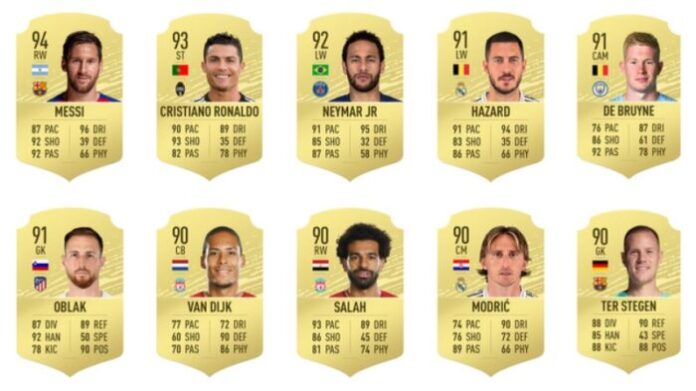With the consistent release of FIFA games every year, player data and statistics are integrated or changed in many different ways. It often gets noticed that individual play databases get entirely renewed to provide a new dimension to Licensed Leagues. No one likes to see their favorite player ranked lower than others, primarily when their statistics figures had dominated the charts the previous year.
Debates and discussions about card numbers and stats often help spike the game’s popularity in the mainstream gaming circle, introducing it to more football enthusiasts. FIFA Index has always stood out as a hot topic; however, it might strike you as to how is this data calculated? How can a player’s dribbling capabilities get subjected to a scale of numbers? This write-up aims to answer all these questions which puzzle your mind.

Who makes the Decisions?
In games like FIFA 20, player data and statistics get evaluated by qualified individuals, hired by the company, EA Sports. Typically, such a team is composed of 25 producers, chosen from within the company; 400 others get selected from outside. These data evaluators are given the task to collect, analyze, and finalize player data while ensuring that the statistics remain fresh. This group of experts gets further assisted by a team of Talent Scouts, who stand 6000 strong; piling the tables with suggestions and well-accessed opinions.
Through a sequence of complex evaluations, the team tries to remain as perfect with their calculations as possible, while also attempting to satiate a demanding fan-base. This team has to consider minute factors, such as injuries and foot-strength, to measure a player’s statistics accurately.

How Talent Scout Works?
In a game as extensive as FIFA20, it’s difficult to analyze every player in the FIFA Index. To simplify this rigorous task, EA Sports hires 6000 volunteers who actively assist in maintaining, and updating player data throughout the year. These volunteers get referred to as FIFA Talent Scouts. Most of these scouts are avid football fans, experienced players, football coaches, and watchers who have been in this scene for years.
A talent scout needs to have a considerable amount of knowledge regarding international and local football teams, which gets used in the evaluation and construction of the index. Cooperation and dedication are what run these teams, providing us with the best statistical assessments. Mueller-Moehring’s group is held responsible for spearheading this operation; verifying data and making any changes necessary. Providing each player with a set of 300 fields, alongside 35 unique attributes is not an easy task.

Mueller Moehring, in several interviews, has discussed how difficult it is to collect new player data from data evaluators; they have to often rely upon online forums and readymade databases.
Calculation of Card Ratings in FIFA 20
In FIFA, a player usually gets attributed by six key statistical points: Dribbling, Physical, Shooting, Defending, and Passing. Apart from these, an overall score gets assessed, which plays a vital role in judging a player’s capabilities. However, to come up with a final score, the calculators have to combine the player’s key attribute points with their international recognition points.
The deduction system ensures proper assessment of ranks and even evaluation of the player. If it were not for this system, then physically powerful and fast players, who are known to perform in lower leagues, might dominate the FIFA Index. Evenly balanced and talented players, who play in higher leagues, might have found their way at the very bottom of the list, if not for this method.

Players with higher physical attributes will perform better on-field, often dominating the course of a match in the game. However, the data calculators do understand the hidden prowess of a robust defense, ranking defense-minded players higher than the ones who rely more on their legs than their heads. A player’s in-game position is decided by an assessment of all the vital statistics, and analyzing the probable advantages of having them on the field. Defensive players are mostly ranked higher than the players with a better finish. At times, “positional Coefficients” might also help determine a player’s in-game rank.
When are the Ratings Updated?
The FIFA Index keeps updating its platform at all times. With the continuous assessment done by Data Editors and Volunteers, it is impossible to stay settled and predetermined numbers on the index on a long-term basis. Data may vary with minute changes in a player’s performance attributes, which may include: newly determining weaknesses, change in physical characteristics, weight, the color of their hair, etc. These attributes are never fixed, and need to be updated as soon as a change gets noticed; often affecting a player’s in-game ranking, and overall evaluation score during a playing season.
Most ratings are usually refreshed every year, usually in January and February. Player upgrades face analyzation after the determination of the Team of the Week, by analyzing their stand-out performance, and their ratings in the matches. Players who had had peak performances during the first half of a session might be ranked higher even if they had underperformed during the second half of the same season.
Apart from these frequent player upgrades, and significant scale changes, the remainder of the data is usually upgraded frequently, in comparison with a player’s real-time performance, outside the game. You might have to make small downloads to notice these newly evaluated changes and make real-time comparisons of the players.
In the end, it’s understandable that analyzing FIFA 20 Player Ratings isn’t as easy as it may look when presented within the game. It takes a ton of effort from a group of individuals to feed us with the best results. Accuracy is only achieved after making re-assessments of facts, and minutely observing a player’s real-life lifestyle. Their hard work and determination should be noticed and appreciated by the fans, and casual players alike. Hopefully, EA Sports will keep filling our plates with excellence like they always have, for years. It is challenging to remain accurate while also producing data to satisfy one’s fan-base.





![Calgary’s Hottest Neighborhoods for Luxury Homebuyers [2024]](https://thewashingtonote.com/wp-content/uploads/2024/04/Calgary-324x160.png)



